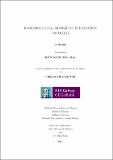| dc.contributor.advisor | van der Putten, Wil | |
| dc.contributor.advisor | Foley, Mark J. | |
| dc.contributor.author | Walsh, Sean | |
| dc.date.accessioned | 2012-11-05T15:53:03Z | |
| dc.date.available | 2012-11-05T15:53:03Z | |
| dc.date.issued | 2011-09-30 | |
| dc.identifier.uri | http://hdl.handle.net/10379/3027 | |
| dc.description.abstract | Biological models potentially o er the ability to predict the response of tumour control to irradiation. A tumour control probability (TCP) model with excellent radiobiological pedigree was developed and examined to predict the clinical response of intermediate risk prostate cancer to external beam radiotherapy (RT) for a variety of fractionation regimes. The model was fitted using the Nelder-Mead (NM) simplex algorithm. In-house organ deformation software was also developed to account for inter-fraction organ motion. The deformation code replicates realistic anatomical deformation through compression and expansion of organs at risk (OARs) based upon the displacements of the prostate. Monte Carlo (MC) methods have been demonstrated to be the best method of modelling radiation transport and dose deposition. MC methods provide a definitive method to quantify the accuracy of these techniques and the accuracy of the procedures used to assess them. This work implements a method to tune a linear accelerator model, in an efficient process. All of these models (TCP, MC and organ deformation) were then utilised to study the potential improvements offered by image guidance, margin reduction and dose escalation to uncomplicated tumour control probability (UCTP). The predicted biological effect of these combined factors was explored in both a phantom study and clinical prostate cases. The results showed that with image guidance, margin reduction and dose escalation, there potentially exists a significant improvement in the therapeutic ratio obtainable for intermediate risk prostate cancer patients. | en_US |
| dc.rights | Attribution-NonCommercial-NoDerivs 3.0 Ireland | |
| dc.rights.uri | https://creativecommons.org/licenses/by-nc-nd/3.0/ie/ | |
| dc.subject | Prostate | en_US |
| dc.subject | Radiobiology | en_US |
| dc.subject | Modelling | en_US |
| dc.subject | Monte Carlo | en_US |
| dc.subject | Science | en_US |
| dc.subject | Physics | en_US |
| dc.title | Radiobiological modelling in Radiation Oncology | en_US |
| dc.type | Thesis | en_US |
| dc.contributor.funder | Science Faculty Fellowship | en_US |
| dc.local.note | Biological and computational models were developed and utilised to quantify the response of prostate cancer patients to irradiation. The results of both a phantom and clinical study showed that through image guidance, margin reduction and dose escalation, a significant improvement in the outcome of prostate cancer patients is achievable. | en_US |
| dc.local.final | Yes | en_US |
| nui.item.downloads | 1222 | |


